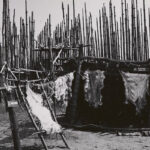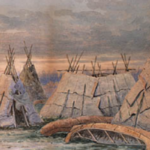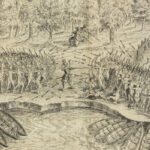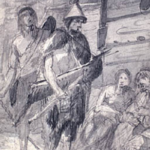Abegweit First Nation: Custodians of the Island Spirit
The Abegweit First Nation, located on Prince Edward Island, represents a vibrant and enduring chapter in the history of the Mi’kmaq Nation. The community takes its name from the Mi’kmaq word Epekwitk, meaning “Cradled on the Waves,” a poetic reference to the island’s beauty and its central place in Mi’kmaq history and culture. From the ancient pre-history of the Mi’kmaq people through their first contact with European explorers to their modern development, the Abegweit First Nation is a testament to resilience, cultural preservation, and the enduring relationship between the Mi’kmaq people and their environment.
Pre-History: Mi’kmaq Origins and Connection to the Land
The ancestors of the Abegweit First Nation, like all Mi’kmaq, have lived in Mi’kma’ki, their traditional homeland, for over 10,000 years. This vast territory spans what are now Atlantic Canada and parts of the northeastern United States. Archaeological findings on Prince Edward Island, including ancient tools, pottery fragments, and remnants of fishing sites, point to a sophisticated society that flourished through a deep understanding of the natural world.
The Mi’kmaq were semi-nomadic, moving seasonally to align with the resources of the land and waters. Summers were spent fishing for salmon, mackerel, and shellfish along the island’s shores, while winters brought smaller groups inland to hunt moose, caribou, and small game. Epekwitk, or Prince Edward Island, offered a rich ecosystem of forests, rivers, and coastal waters that provided sustenance and supported their cultural practices.
The Mi’kmaq worldview was deeply spiritual, emphasizing the interconnectedness of all living things. This belief system guided their practices, from fishing and hunting to storytelling and ceremonies. The island itself was seen not just as a home but as a living entity imbued with spirit and deserving of respect and stewardship.
Governance and Social Structure
The governance of the Mi’kmaq, including those of Abegweit, was based on consensus, respect, and the collective good of the community. Each region of Mi’kma’ki was led by a Sagamore (chief), who made decisions in consultation with elders and other respected members of the community. The Mi’kmaq Grand Council (Santé Mawiómi) united the districts of Mi’kma’ki, addressing issues such as land use, resource management, and alliances with other Indigenous groups or European settlers.
Oral traditions played a central role in preserving Mi’kmaq knowledge and identity. Stories of Glooscap, the legendary figure who taught the Mi’kmaq how to live in harmony with nature, were passed from one generation to the next, providing moral guidance and a sense of cultural continuity.
First Contact with Europeans
The arrival of European explorers in the 15th and 16th centuries introduced profound changes to Mi’kmaq life. Early encounters were primarily with Basque, Breton, and Norman fishermen who ventured into the waters around Prince Edward Island for its rich cod fisheries. These interactions were largely transactional, with the Mi’kmaq trading furs, fish, and other resources for European goods such as metal tools, beads, and cloth.
The establishment of French settlements in the 17th century deepened these relationships. French explorers, including Samuel de Champlain, sought alliances with the Mi’kmaq to support their colonization efforts. The fur trade became a cornerstone of Mi’kmaq-European relations, with the Mi’kmaq of Abegweit actively participating in the exchange of beaver pelts and other goods. While this trade brought material benefits, it also disrupted traditional economies and introduced dependencies.
The arrival of Europeans also brought devastating consequences. Epidemics of smallpox, measles, and other diseases swept through Mi’kmaq communities, decimating populations and creating profound social and cultural upheaval. Despite these challenges, the Mi’kmaq of Abegweit adapted to the new realities, maintaining their cultural identity and resilience.
Relationships with Missionaries and Settlers
French missionaries, particularly Jesuits, established missions among the Mi’kmaq during the 17th and 18th centuries. The Mi’kmaq of Abegweit, like many others, were drawn into these efforts, adopting elements of Catholicism while retaining aspects of their traditional spirituality. This blending of beliefs allowed the Mi’kmaq to navigate the pressures of colonization without losing their cultural essence.
During the Seven Years’ War (1756–1763), the Mi’kmaq allied with the French against the British, motivated by shared interests in resisting British expansion. However, the British victory in 1763 marked a turning point. Prince Edward Island, or Île Saint-Jean as it was known under the French, came under British control, leading to increased settler encroachment on Mi’kmaq lands.
The 19th and 20th Centuries: Adaptation and Resilience
The 19th century brought significant challenges to the Mi’kmaq of Abegweit. The imposition of the Indian Act (1876) and the establishment of reserves confined the Mi’kmaq to small parcels of their traditional territories. For the Abegweit First Nation, this meant adapting to life on restricted lands while facing economic and social pressures.
Fishing remained a vital part of the community’s economy and culture, with the surrounding waters continuing to provide sustenance and a connection to their ancestors. Traditional crafts such as basket-making, quillwork, and beadwork also became important sources of income and cultural preservation.
The residential school system, which aimed to assimilate Indigenous children by severing their ties to their language and culture, caused profound trauma for many Mi’kmaq families. Despite these hardships, the elders of Abegweit worked tirelessly to preserve Mi’kmawi’simk, the Mi’kmaq language, and to pass down their traditions through storytelling, ceremonies, and seasonal gatherings.
Cultural Revitalization and Environmental Stewardship
In recent decades, the Abegweit First Nation has become a leader in cultural revitalization and environmental stewardship. The community has embraced initiatives to restore the Mi’kmawi’simk language and celebrate traditional practices, such as drumming, dancing, and storytelling, fostering a renewed sense of pride and unity.
Environmental stewardship has also been a central focus for Abegweit. The community has undertaken efforts to protect fish habitats, restore ecosystems, and promote sustainable practices, reflecting the Mi’kmaq’s enduring relationship with the land and sea. These initiatives are informed by traditional ecological knowledge, passed down through generations, and supported by modern conservation methods.
Abegweit Today: A Thriving Community
Today, the Abegweit First Nation is a dynamic and forward-looking community that balances cultural preservation with modern innovation. Investments in education, healthcare, and economic development have transformed Abegweit into a model of resilience and self-sufficiency. The community’s initiatives in small business development, eco-tourism, and cultural heritage programs highlight their ingenuity and commitment to creating opportunities for future generations.
The annual Abegweit Powwow is a vibrant celebration of Mi’kmaq culture, drawing participants from across Mi’kma’ki and beyond. This event, along with other cultural programs, ensures that the traditions of the Abegweit Mi’kmaq remain vibrant and alive.
Conclusion: A Legacy of Strength and Continuity
The history of the Abegweit First Nation is a testament to the resilience, adaptability, and cultural richness of the Mi’kmaq people. From their ancient presence on Prince Edward Island to their pivotal role in early European trade and their modern achievements in cultural revitalization and environmental stewardship, Abegweit stands as a beacon of Mi’kmaq identity and strength.
As an elder from Abegweit once said, “Our land, our language, and our traditions are the heart of who we are. By honouring them, we honour our ancestors and build a future for our children.”
References
- Whitehead, Ruth Holmes. The Old Man Told Us: Excerpts from Micmac History, 1500–1950. Nimbus Publishing, 1991.
- Jesuit Relations. Documents of the Missions to New France. McGill University Press, 1962.
- Conrad, Margaret. A Concise History of Canada. Cambridge University Press, 2012.
- Abegweit Cultural Centre. Cradled on the Waves: The History of Abegweit First Nation. Abegweit Publications, 2019.
- Ridington, Robin. Trail to Heaven: Knowledge and Narrative in a Northern Native Community. Douglas & McIntyre, 1988.
- Environmental Justice Advocacy Group. Stewardship and Sovereignty: Indigenous Environmental Leadership in Canada. University of Guelph Press, 2019.
- Mi’kmaq Grand Council. Santé Mawiómi: Traditions and Governance of the Mi’kmaq Nation. Halifax Press, 1985.
- Johnston, Basil. Ojibway Heritage. McClelland & Stewart, 1976.
- Neeposh, Thomas. “Preserving the Waters: The Vision of Abegweit First Nation.” CBC News, 2021.
- Snow, Dean R. The Iroquois. Blackwell, 1994.



